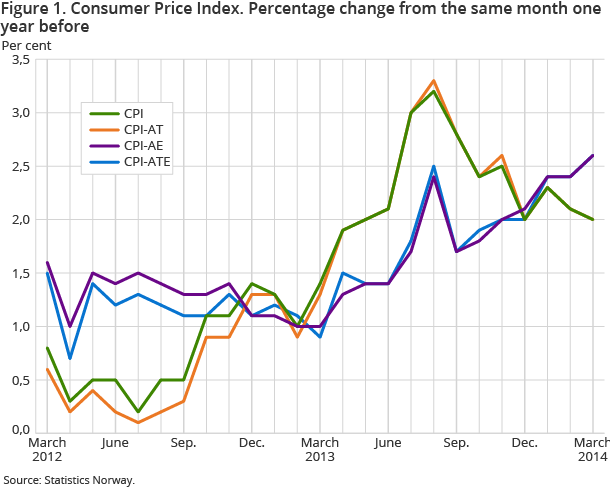Content
Published:
This is an archived release.
CPI up 0.2 per cent
The Consumer Price Index (CPI) rose by 0.2 per cent from February to March, mainly due to higher prices of clothes. The year-to-year growth in the CPI was 2.0 per cent in March, while the CPI-ATE was 2.6 per cent in the same period.
| Monthly change (per cent) | 12-month rate (per cent) | Index | |
|---|---|---|---|
| February 2014 - March 2014 | March 2013 - March 2014 | March 2014 | |
| CPI All-item index | 0.2 | 2.0 | 136.1 |
| Food and non-alcoholic beverages | 0.9 | 5.2 | 128.7 |
| Housing, water, electricity, gas and other fuels | -0.6 | 0.7 | 166.9 |
| Transport | 0.1 | 1.5 | 148.0 |
| Recreation and culture | -0.3 | 1.7 | 117.1 |
| Clothing and footwear | 4.2 | 0.4 | 54.8 |
| CPI-ATE (july 1999 = 100) | 0.5 | 2.6 | 126.9 |
| CPI by delivery sector | |||
| Other consumer goods produced in Norway | -0.7 | 0.0 | 161.5 |
| Imported consumer goods | 1.0 | 1.7 | 91.2 |
| Other services with wages as dominating price factor | 0.4 | 3.5 | 208.0 |

The CPI was 136.1 (1998=100) in March 2014, compared to 133.4 in March 2013, which corresponds to a year-to-year growth of 2.0 per cent.
Monthly change: higher clothing prices
The CPI increased 0.2 per cent from February to March. Clothing prices contributed most to the rise with an increase of 4.5 per cent, and the price increase can be seen in relation to new clothing lines for the spring and summer. The prices of food and non-alcoholic beverages rose by 0.9 per cent combined in the same period. The food prices rose by 0.7 per cent, and the higher prices of meat and dairy products made the largest contribution. The prices of non-alcoholic beverages showed an increase of 2.1 per cent in the same period, mainly due to higher prices of mineral water and fruit juices.
The prices of furniture, furnishings and decoration rose by 2.7 per cent from February to March, mostly due to higher prices of furniture. In the same period, prices of shoes increased 3.4 per cent. Prices of maintenance and repair of personal transport equipment rose 1.0 per cent.
The increase in the CPI was dampened by a price decrease of 4.2 per cent in electricity including grid rent. The price reduction can be seen in connection with higher temperatures and lower demand than usual for the season. Other consumption groups that dampened the CPI were price falls of fuels and lubricants of 1.0 per cent, and 3.0 per cent of non-durable household goods.
Year-to-year growth: higher food prices and rents
The CPI rose by 2.0 per cent from March 2013 to March 2014. Over the last twelve months, food prices have increased by 5.4 per cent and were the main contributor to the growth. Higher prices of dairy products, meat, fish and fruits contributed most to the joint increase. Imputed rentals for owner-occupiers rose 3.3 per cent in the same period.
From March 2013 to March 2014, prices of furniture, furnishings and decorations rose 10.2 per cent, mainly due to higher prices of furniture. Prices of operation of personal transport equipment went up 3.0 per cent in the same period. Alcoholic beverages and tobacco showed a combined price increase of 3.9 per cent over the last twelve months. In the same period, prices of restaurant services rose 2.7 per cent. Actual rentals paid by tenants rose 3.6 per cent.
The year-to-year growth in the CPI was mainly curbed by lower prices of electricity. Prices of electricity including grid rent showed a decline of 11.0 per cent from March 2013 to March 2014. CPI excluding electricity (CPI-AE) rose 2.5 per cent in the last twelve months, hence electricity prices contributed to a 0.5 percentage point decrease in the year-to-year growth in the CPI. In the same period, airfares and prices of telephone services fell 12.2 and 2.6 per cent respectively, thus pulling the CPI down.
Change in the year-to-year growth: weaker growth rate in the CPI
The year-to-year growth in the CPI fell from 2.1 per cent in February 2014 to 2.0 per cent in March 2014. The main contributor to the decline was the price development of electricity. Prices of electricity including grid rent fell 4.2 per cent from February to March 2014, while increasing 3.5 per cent in the same period in 2013. On the other hand, the price development of food pulled the growth in the CPI up. Prices of food showed an increase of 0.7 per cent from February to March this year, while falling 0.7 per cent in the same period last year.
The year-to year growth in the CPI-ATE was 2.6 per cent in March, up 0.2 percentage points from February. The development of food prices, as mentioned above, together with the price development of furniture were the main contributors to the increased growth in the CPI-ATE.
Contact
-
Statistics Norway's Information Centre
E-mail: informasjon@ssb.no
tel.: (+47) 21 09 46 42
-
Konsumprisindeksen
E-mail: konsumprisindeksen@ssb.no
tel.: (+47) 62 88 56 34
-
Camilla Rochlenge
E-mail: camilla.rochlenge@ssb.no
tel.: (+47) 40 90 23 72
-
Kjersti Nyborg Hov
E-mail: kjersti.nyborg.hov@ssb.no
tel.: (+47) 40 90 23 63
-
Gunnar Larsson
E-mail: gunnar.larsson@ssb.no
tel.: (+47) 40 90 26 79
-
Trym Kristian Økland
E-mail: trym.okland@ssb.no
tel.: (+47) 46 81 09 15
